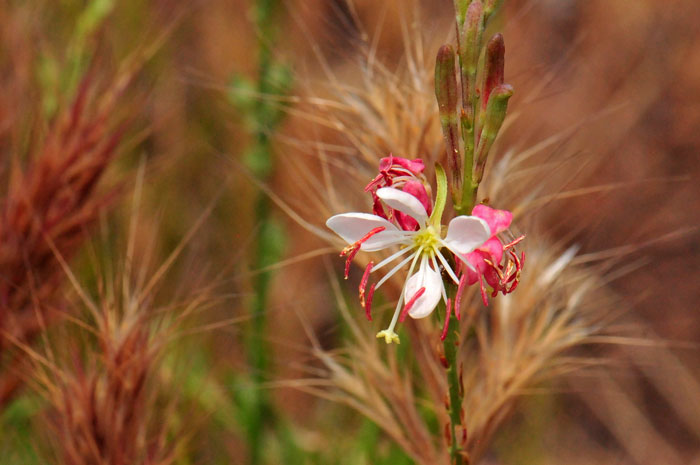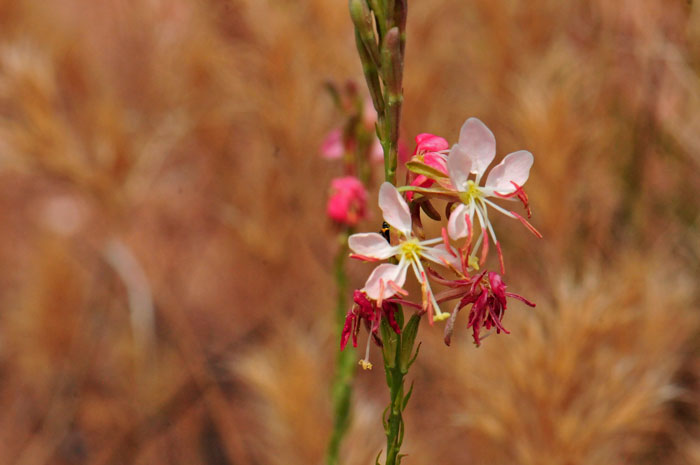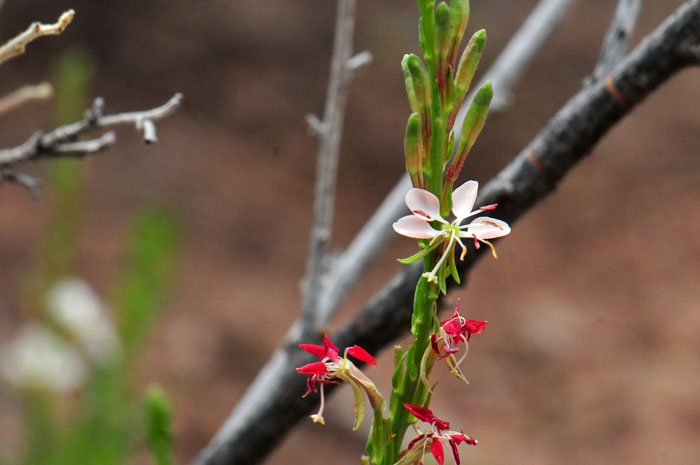Oenothera curtiflora, (Gaura parviflora) Velvetweed



Scientific Name: Oenothera curtiflora (Gaura parviflora)
Common Name: Velvetweed
Also Called: Lizard Tail, Smallflowered Gaura, Velvet Weed, Velvety Gaura, Willow Gaura, (Spanish: Linda Tarde)
Family: Onagraceae, Evening Primrose Family
Synonyms: (Gaura mollis, Gaura parviflora, Gaura parviflora var. lachnocarpa, Gaura parviflora var. typica)
Status: Native
Duration: Annual
Size: Up to 6 feet or so.
Growth Form: Forb/herb; large taproot, branching, herbage glandular.
Leaves: Green; alternate, upper leaves sessile, soft velvety, elliptic to oblanceolate.
Flower Color: Pink, pale to bright pink; flowering stem a spike-like erect slender raceme, multiple small flowers along stem, sepals curved back; fruit woody, indehiscent.
Flowering Season: June to October.
Elevation: 1,000 to 6,000 feet.
Habitat Preferences: Waste lands, roadsides, disturbed areas.
Recorded Range: Velvetweed is found throughout the United States.
In Arizona Velvetweed is also found throughout most of the state.
North America & US County Distribution Map for Oenothera curtiflora.
U.S. Weed Information: Oenothera curtiflora is listed in: Weeds of the West. Western Society of Weed Science in cooperation with Cooperative Extension Services, University of Wyoming. Laramie, Wyoming. Plants included here may become weedy or invasive.
Invasive/Noxious Weed Information: No information available.
Wetland Indicator: In North America Oenothera curtiflora has the following wetland designations; Arid West, FACU; Atlantic and Gulf Coastal Plain, UPL; Eastern Mountains and Piedmont, UPL; Great Plains, UPL; Midwest, UPL; Northcentral & Northeast, FACU, Western Mountains, Valleys, and Coast, FACU.
FACU = Facultative Upland, usually occur in non-wetlands, but may occur in wetlands
UPL = Obligate Upland, almost never occur in wetlands.
Threatened/Endangered Information: No information available.
The Plant List includes 706 scientific plant names of species rank for the genus Oenothera. Of these 150 are accepted species names. 24 or so species in Arizona and California, 28 or so species in New Mexico and 47 or so species in Texas.
Comments: Velvetweed has long been known under the botanical name of Gaura parviflora.
Also see in Southwest Desert Flora: Tufted Evening Primrose, Oenothera caespitosa; California Suncup, Oenothera californica; Crownleaf Evening Primrose, Oenothera coronopifolia; Dune Evening Primrose, Oenothera deltoides; Hooker's Evening Primrose, Oenothera elata; Large Yellow Desert Primrose, Oenothera primiveris; Rose Evening Primrose, Oenothera rosea; Mexican Evening Primrose, Oenothera speciosa and Scarlet Beeblossom, Oenothera suffrutescens.

